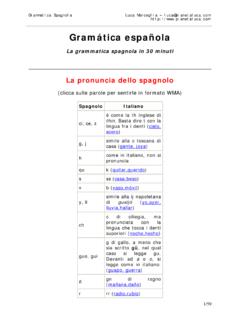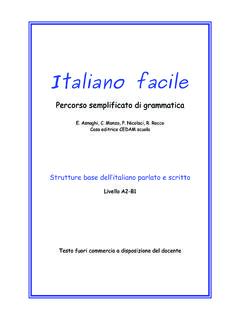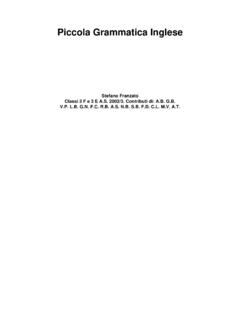Transcription of GRAMMATICA INGLESE DI BASE - Imparare Online
1 GRAMMATICA INGLESE DI base BASI PARTI DEL DISCORSO NUMERI e DATE SOSTANTIVI PLURALE REGOLARE DEI SOSTANTIVI PLURALE IRREGOLARE DEI SOSTANTIVI SOSTANTIVI NUMERABILI E NON GENITIVO SASSONE VERBI TEMPI ESSERE AVERE FORMAZIONE DEL SIMPLE PRESENT TENSE FORME INTERROGATIVA E NEGATIVA DEL SIMPLE PRESENT TENSE FORMAZIONE DEL PRESENT CONTINUOUS TENSE FORME INTERROGATIVA E NEGATIVA DEL PRESENT CONTINUOUS TENSE SIMPLE PRESENT O PRESENT CONTINUOUS? FORMAZIONE DEL SIMPLE PAST TENSE (VERBI REGOLARI) FORMAZIONE DEL SIMPLE PAST TENSE (VERBI IRREGOLARI) FORME INTERROGATIVA E NEGATIVA DEL SIMPLE PAST TENSE FORMAZIONE ED USO DEL PAST CONTINUOUS TENSE FORMAZIONE DEL PRESENT PERFECT TENSE USO DEL PRESENT PERFECT TENSE PRESENT PERFECT E SIMPLE PAST FUTURO CON WILL FUTURO CON BE GOING TO QUATTRO MODI DI PARLARE AL FUTURO PAST PERFECT TENSE VERBI DI STATO E DI MOTO DISCORSO INDIRETTO VOCE VOCE PASSIVA GERUNDIO E INFINITO GERUNDI GERUNDI E INFINITI MODALI CAN COULD MAY MIGHT WILL WOULD SHALL SHOULD DON'T HAVE TO E MUSTN'T CONDIZIONALI CONDIZIONALE CONDIZIONALE DEL TIPO ZERO IPOTETICO DEL PRIMO TIPO IPOTETICO DEL SECONDO TIPO IPOTETICO DEL TERZO TIPO CAUSATIVI CAUSATIVI (FARE+verbo)
2 pronomi PERSONALI RIFLESSIVI RELATIVI IT E THERE IMPERSONALI QUESTION TAGS AGGETTIVI AGGETTIVI E pronomi possessivi COMPARATIVI E SUPERLATIVI REGOLARI POSIZIONE DEGLI AGGETTIVI AVVERBI AVVERBI LOCUZIONI AVVERBIALI PROPOSIZIONI AVVERBIALI ARTICOLI-DETERMINANTI SCELTA DELL'ARTICOLO CORRETTO SOME E ANY PREPOSIZIONI PREPOSIZIONI base PREPOSIZIONI DI LUOGO CONGIUNZIONI CONGIUNZIONI COORDINATIVE DI base CONGIUNZIONI SUBORDINATIVE DI base Questa GRAMMATICA a cura di Raffaele Nardella, insegnante di lingua INGLESE presso l'ITIS Giorgi di Milano. itisgiorgi & newspeak 2000 PARTI DEL DISCORSO E' importante poter riconoscere e identificare le diverse parti del discorso in INGLESE cos da poter comprendere le spiegazioni grammaticali e usare la forma giusta della parola nel posto giusto. Ecco una breve spiegazione di quello che sono le parti del discorso. SOSTANTIVO (noun) il sostantivo una parola che determina una persona, un luogo, una cosa, un'idea, una creatura vivente, una qualit , o un'azione.
3 Esempi: cowboy, theatre, box, thought, kindness, arrival VERBO (verb) il verbo una parola che descrive un'azione (fare qualcosa) o uno stato (essere qualcosa). Esempi: walk, talk, think, believe, live, like, want AGGETTIVO (adjective) l'aggettivo una parola che descrive un sostantivo, ci dice qualcosa del sostantivo. Esempi: big, yellow, thin, amazing, wonderful, quick, important AVVERBIO (adverb) l'avverbio una parola che di solito descrive un verbo, ci dice come si fa qualcosa o pu dirci quando e dove avvenuto qualcosa . Esempi: slowly, intelligently, well, yesterday, tomorrow, here, everywhere PRONOME (pronoun) il pronome usato al posto di un sostantivo per evitare di ripeterlo. Esempi: I, you, he, she, it, we, they CONGIUNZIONE (conjunction) la congiunzione unisce due parole, locuzioni o frasi. Esempi: but, so, and, because, or PREPOSIZIONE (preposition) la preposizione viene di solito prima di un sostantivo, pronome o locuzione ed unisce il sostantivo a qualche altra parte della frase.
4 Esempi: on, in, at, by, with, under, through INTERIEZIONE (interjection) l'interiezione, o esclamazione, un tipo di parola insolita perch spesso sta da sola ed esprime emozione o sorpresa ed seguita di solito dal punto esclamativo. Esempi: Hello! Oh no! Ouch! Ha! ARTICOLO (article) l'articolo viene usato per introdurre un sostantivo. Esempi: the, a, an NUMERI E DATE Numeri cardinali: 0 1 2 3 4 5 6 7 8 9 10 Nought/Zero/OOne Two Three Four Five Six Seven Eight Nine Ten 21 22 23 24 25 26 27 28 29 30 Twenty-one Twenty-two Twenty-three Twenty-four Twenty-five Twenty-six Twenty-seven Twenty-eight Twenty-nine Thirty 11 12 13 14 15 16 17 18 19 20 Eleven Twelve Thirteen Fourteen Fifteen Sixteen Seventeen Eighteen Nineteen Twenty 40 50 60 70 80 90 100 1,000 10,000 100,000 1,000,000 Forty Fifty Sixty Seventy Eighty Ninety A (one) hundred A (one) thousand Ten thousand A (one) hundred thousand A (one) million In INGLESE per separare le cifre delle migliaia si usa la virgola, per separare invece le cifre decimali si usa il punto.
5 Numeri Ordinali: 1st 2nd 3rd 4th 5th 6th 7th 8th 9th 10th The first The second The third The fourth The fifth The sixth The seventh The eighth The ninth The tenth 21st 22nd 23rd 24th 25th 26th 27th 28th 29th 30th The twenty-first The twenty-second The twenty-third The twenty-fourth The twenty-fifth The twenty-sixth The twenty-seventh The twenty-eighth The twenty-ninth The thirtieth 11th 12th 13th 14th 15th 16th 17th 18th 19th 20th The eleventh The twelfth The thirteenth The fourteenth The fifteenth The sixteenth The seventeenthThe eighteenth The nineteenth The twentieth 40th 50th 60th 70th 80th 90th 100th 1,000th 1,000,000thThe fortieth The fiftieth The sixtieth The seventieth The eightieth The ninetieth The hundredth The thousandth The millionth I numeri ordinali si formano aggiungendo il suffisso th ai relativi numeri cardinali, con qualche eccezione ortografica: the first, the second, the third, the twenty-first, the twenty-second, the twenty-third, ecc.
6 DATE In INGLESE la data viene formulata utilizzando il numero ordinale e pu essere espressa in due modi: Es: 7th May, 1995 si legge the seventh of May nineteen ninety-five May 7th, 1995 si legge May the seventh nineteen ninety-five L anno non mai preceduto dall articolo e i suoi numeri vengono letti a coppie. Se la seconda coppia costituita da due zeri, dopo la lettura della prima coppia si pronuncia hundred, se invece costituita da una cifra inferiore a dieci, si pronuncia hundred and e si aggiunge la cifra. Es: 21st July 1900 si legge the twenty-first of July nineteen hundred 6th December 1905 si legge the sixth of December nineteen hundred and five ATTENZIONE: l'anno 2000 si legge two thousand, il 2001 two thousand and one e cos via. MONTHS (mesi) DAYS OF THE WEEK (giorni della settimana) January May September February June October March July November April August December Sunday Thursday Monday Friday Tuesday Saturday Wednesday I mesi e i giorni della settimana vanno scritti sempre con la lettera REGOLARE DEI SOSTANTIVI Quasi tutti i sostantivi in INGLESE hanno sia la forma singolare che quella plurale.
7 Il plurale di solito si forma aggiungendo il suffisso S. Esistono inoltre alcune forme irregolari che sono illustrate in un'altra sezione di questa GRAMMATICA . COME FORMARE IL PLURALE PARTE FINALE DEL SOSTANTIVO FORMAZIONE DEL PLURALE ESEMPI -s, -sh, -ch, -x, -z, -o si aggiunge -es tax - taxes boss - bosses consonante + y si cambia y in i e s'aggiunge -es fly - flies baby - babies maggior parte degli altri si aggiunge il suffisso -s cat - cats day - days PLURALE IRREGOLARE DEI SOSTANTIVI Sebbene la maggior parte dei sostantivi formi il plurale regolarmente, altri hanno plurali insoliti o irregolari. TIPI DI PLURALI IRREGOLARI TIPO DI SOSTANTIVO FORMAZIONE DEL PLURALE ESEMPI termina con -fe cambia f in v e poi s'aggiunge -s knife - knives life - lives termina con -f cambia f in v e poi s'aggiunge -es half - halves wolf - wolves termina con -us cambia -us in -i cactus - cacti nucleus - nuclei termina con -is cambia -is in -es analysis - analyses crisis - crises termina con -on cambia -on in -a phenomenon - phenomena altri tipi cambia la vocale o cambia la parola o s'aggiunge una finale differente man-men foot-feet tooth-teeth child-children person-peoplenon cambia singolare e plurale sono gli stessi sheep deer SOSTANTIVI NUMERABILI E NON NUMERABILI In INGLESE ci sono due tipi di sostantivi: sostantivi numerabili (count nouns) e non numerabili (non-count nouns).
8 I non numerabili di solito non hanno il plurale. Di seguito sono illustrate le differenze tra i due tipi: COUNT NOUNS Sono sostantivi che possono essere numerati. Inoltre, quando un count noun singolare viene spesso preceduto dall'articolo indeterminativo a/an There are two books on the table. There is an elephant in my NOUNSSono di solito sostantivi che non possono essere numerati, come riso (rice) o acqua (water). I sostantivi non numerabili hanno la sola forma singolare; quando non compaiono da soli sono preceduti dalle forme some, any, no Could I have some water, please? I'd like rice with my steak. I sostantivi numerabili sono di solito oggetti che possono essere numerati, mentre quelli non numerabili sono spesso sostanze, come cibi e bevande, che non possono essere facilmente contate ( sand "sabbia", water "acqua", bread "pane") o sono idee astratte (come nature "natura", space "spazio" o entertainment "divertimento").
9 Ecco alcuni esempi: COUNT NOUNS: pen, table, car, idea, answer, class, exam, shoe NON-COUNT NOUNS: education, intelligence, clothing, soap, air, cheese, grass, literature COME NUMERARE I SOSTANTIVI NON NUMERABILI Talvolta possiamo avere il bisogno di numerare i sostantivi non numerabili per indicare una quantit . A tale scopo si possono usare delle parole di misurazione o di conteggio come ad esempio: a bar of chocolate una barra di cioccolato two loaves of bread due pagnotte di pane three slices of meat tre fettine di carne E' utile conoscere alcune delle pi comuni parole di misurazione o di conteggio e saperle usare. Eccone degli esempi: PAROLA DI MISURAZIONE E CONTEGGIO SOSTANTIVI USATI CON ESSA bar chocolate soap cube sugar ice game tennis football cards glass wine beer water juicepiece of advice information clothing furniture machinery E' necessario conoscere la differenza tra i sostantivi numerabili e non numerabili per: usare gli articoli (the, a/an) correttamente usare i plurali dei sostantivi correttamente usare le forme (much/many) correttamenteGENITIVO SASSONE Il GENITIVO SASSONE viene spesso usato in INGLESE per indicare il possesso, soprattutto quando il possessore - persona o animale Es: My brother s car is red ("La macchina di mio fratello rossa") - nazione o citt Es: London s squares are large ("Le piazze di Londra sono grandi") - avverbi di tempo Es: Today s match is at ("La partita di oggi alle 4") - espressione di distanza e peso Es.
10 It s a 700 kilometers journey ( "E un viaggio di 700 Km") - pronomi indefiniti Es: Everyone s body temperature is 37 C ("La temperatura corporea di tutti di 37 C") Il GENITIVO SASSONE si costruisce secondo il seguente schema: possessore + s + persona, animale o cosa posseduta (senza articolo) Quando il possessore termina in s, pu essere seguito solo dall apostrofo senza s: Es :It s a 700 kilometers journey ("E un viaggio di 700 Km") Quando vi sono pi possessori: - si aggiunge s solo all ultimo possessore se il possesso condiviso Es: John and Mary s parents are in Sweden. ("I genitori di John e Mary sono in Svezia) - si aggiunge s solo a ciascun possessore se il possesso individuale Es: John s and Mary s parents are in Sweden. ("I genitori di John e quelli di Mary sono in Svezia) I seguenti sostantivi sono di solito omessi quando hanno la funzione di "cosa posseduta": - house - restaurant - shop / store - hospital - church / cathedral - office Es: She is going to Bob s ("Sta andando a casa di Bob") Es: Where is the nearest chemist s ?


